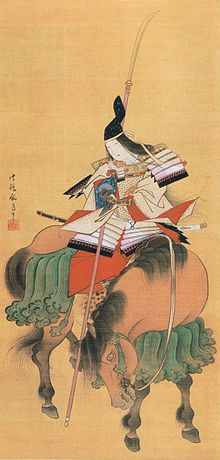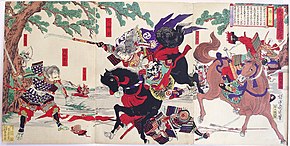Tomoe Gozen

Tomoe Gozen (巴 御前, pronounced [tomo.e]; c. 1157 – 1247) was a late twelfth-century female samurai warrior (onna-bugeisha), known for her bravery and strength.[1] She married Minamoto no Yoshinaka and served him in the Genpei War[2] and was a part of the conflict that led to the first shogunate in Japan.[3]
Her family had strong affiliations with Yoshinaka. Her father, Nakahara Kanetō was a strong supporter of Yoshinaka and also his foster father, who raised him since he was two. Her mother was Yoshinaka's wet nurse. Two of her elder brothers also served Yoshinaka as generals.[3] She is best known for her loyalty and courage at the Battle of Awazu in 1184.[3]
History
According to one historical account,
Tomoe was especially beautiful, with white skin, long hair, and charming features. She was also a remarkably strong archer, and as a swordswoman she was a warrior worth a thousand, ready to confront a demon or a god, mounted or on foot. She handled unbroken horses with superb skill; she rode unscathed down perilous descents. Whenever a battle was imminent, Yoshinaka sent her out as his first captain, equipped with strong armor, an oversized sword, and a mighty bow; and she performed more deeds of valor than any of his other warriors.
After defeating the Taira and driving them into the western provinces, Yoshinaka took Kyoto and desired to be the leader of the Minamoto clan. His cousin Yoritomo was prompted to crush Yoshinaka, and sent his brothers Yoshitsune and Noriyori to kill him. Yoshinaka fought Yoritomo's forces at the Battle of Awazu on February 21, 1184, where Tomoe Gozen purportedly took at least one head of the enemy. Although Yoshinaka's troops fought bravely, they were outnumbered and overwhelmed. When Yoshinaka was defeated there, with only a few of his soldiers standing, he told Tomoe Gozen to flee because he wanted to die with his foster brother Imai no Shiro Kanehira and he said that he would be ashamed if he died with a woman.[5]

There are varied accounts of what followed. At the Battle of Awazu in 1184,[6] she is known for beheading Honda no Morishige of Musashi.[7] She is also known for having killed Uchida Ieyoshi and for escaping capture by Hatakeyama Shigetada.[8]
In fiction and culture
Tomoe Gozen's life, set in a fantasy Japan, is the subject of a trilogy of novels by Jessica Amanda Salmonson (The Disfavored Hero, The Golden Naginata and Thousand Shrine Warrior, 1981–1984).
Tomoe Gozen is the title character in C. J. Cherryh's 1988 novel, The Paladin.
Tomoe Gozen is the basis of the Persona of Chie Satonaka in the 2008 video game Persona 4.
Tomoe Gozen is one of the supporting characters in the 2010 Syfy series Riverworld.
Tomoe Gozen appears as an enemy at first with her alias as 'Archer Inferno', but becomes a playable Archer-class servant in Fate/Grand Order.
Tomoe Gozen appears as a character in the podcast Film Reroll.
Tomoe Gozen appears as a character in the manga and anime Nurarihyon no Mago.
Tomoe Gozen appears in Heian Shrine's Jidai Matsuri (Festival of the Ages), which is held on October 22 each year.
Tomoe Gozen appears as a summonable Servant of the Archer-Class in the mobile game Fate/Grand Order.
Gallery
-
Tomoe Gozen—artist's impression by Kikuchi Yōsai (1781–1878)
-
Tomoe Gozen in the Battle of Awazu—by Utagawa Yoshikazu
-
Tomoe Gozen at the Yodo River—by Toyohara Chikanobu (1838–1912)
-
Tomoe Gozen defeats Uchida Saburō—by Tsukioka Yoshitoshi (1839–1892)
-
Memorial to Tomoe at Gichū-ji, Ōtsu, Shiga Prefecture
Notes
- ^ Nussbaum, Louis Frédéric et al. (2005). "Tomoe Gozen" in Japan Encyclopedia, p. 984., p. 984, at Google Books
- ^ Turnbull, Stephen (1987). Battles of the Samurai. Arms and Armour Press. p. 14. ISBN 978-0853688266.
- ^ a b c Pennington, Reina (2003). Amazons to Fighter Pilots - A Biographical Dictionary of Military Woman (Volume Two). Westport, Connecticut: Greenwood Press. pp. 437–438. ISBN 978-0-313-32708-7.
- ^ McCullough, Helen Craig. (1988). The Tale of the Heike, p. 291., p. 291, at Google Books; Kitagawa, Hiroshi et al.(1975). The Tale of the Heike, p. 519.
- ^ The Tales of the Heike. Translated by Burton Watson. Columbia University Press. 2006. p. 86. ISBN 9780231138031.
- ^ Turnbull, Stephen (1998). The Samurai Sourcebook. Cassell & Co. p. 204. ISBN 978-1854095237.
- ^ Faure, Bernard. (2003). The Power of Denial: Buddhism, Purity, and Gender, p. 211, p. 211, at Google Books; Kitagawa, p. 521.
- ^ Joly, Henri L. (1967). Legend in Japanese Art, p. 540.
References
- Faure, Bernard (2003). The Power of Denial: Buddhism, Purity, and Gender. Princeton: Princeton University Press. ISBN 978-0-691-09170-9; ISBN 978-0-691-09171-6; OCLC 49626418.
- Joly, Henri L. (1967). Legend in Japanese Art: A Description of Historical Episodes, Legendary Characters, Folk-lore Myths, Religious Symbolism, Illustrated in the Arts of Old Japan. Rutland, Vermont: Tuttle. ISBN 978-0-8048-0358-8; OCLC 219871829.
- Kitagawa, Hiroshi and Bruce T. Tsuchida, ed. (1975). The Tale of the Heike. Tokyo: University of Tokyo Press. ISBN 0-86008-128-1; OCLC 164803926.
- McCullough, Helen Craig (1988). The Tale of the Heike. Palo Alto, California: Stanford University Press. ISBN 978-0-8047-1418-1; OCLC 16472263.
- Nussbaum, Louis Frédéric and Käthe Roth (2005). Japan Encyclopedia. Cambridge: Harvard University Press. ISBN 978-0-674-01753-5; OCLC 48943301.
External links
- Famous Women of Japanese History. The Samurai Archives Japanese History Page.
- Shea, L. "Tomoe Gozen - Female Samurai". Bella Online, 2009.






